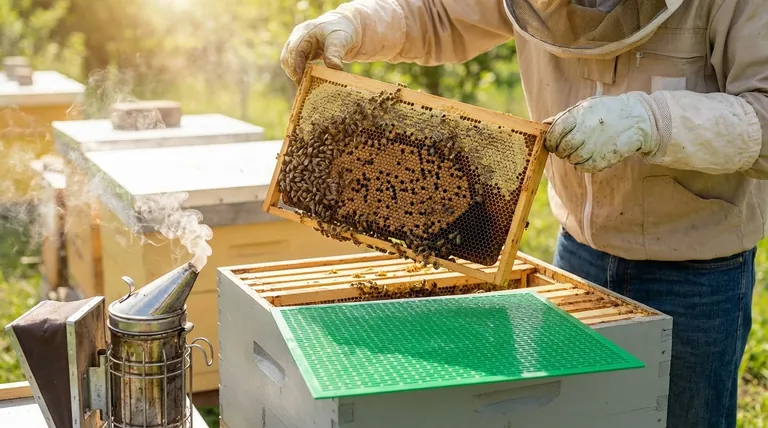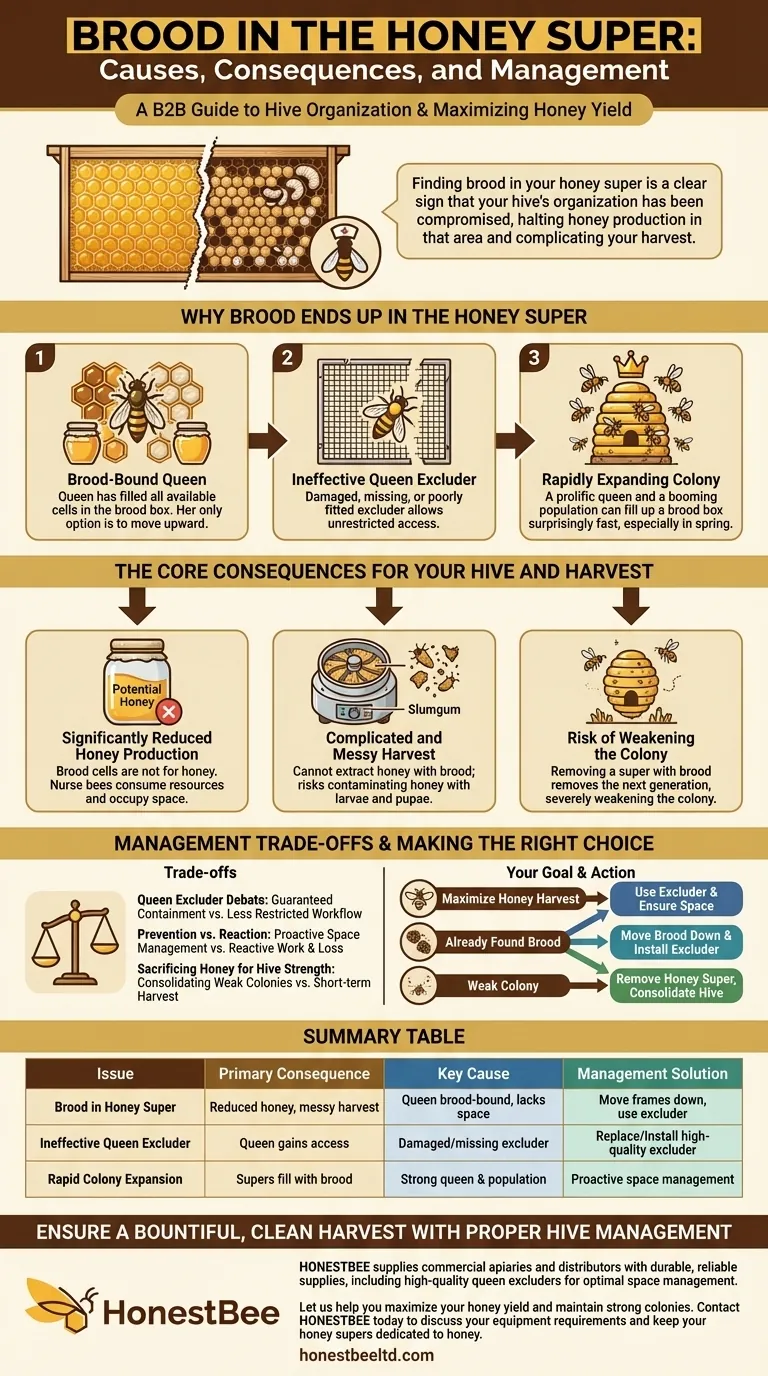Finding brood in your honey super is a clear sign that your hive's organization has been compromised. The most immediate consequence is that the cells containing brood (eggs, larvae, and pupae) will not be used for honey storage. Nurse bees are biologically programmed to remain in the super to feed and care for this developing generation, which effectively halts honey production in that area and complicates your eventual harvest.
Brood in the honey super is not a disaster, but a signal that the queen has run out of laying space in the brood chamber below. This misallocation of hive resources directly reduces your honey yield and indicates a need for immediate management intervention.

Why Brood Ends Up in the Honey Super
The presence of brood where you expect honey is almost always a symptom of a space management issue. The queen is not making a mistake; she is desperately seeking empty cells to continue her essential job of laying eggs.
The 'Brood-Bound' Queen
The most common cause is that the queen has filled all available cells in the brood box. When every appropriate cell is occupied with existing brood, pollen, or honey, the hive is considered "brood-bound" or "honey-bound." In this scenario, her only option is to move upward past the typical honey barrier and into the supers.
An Ineffective or Absent Queen Excluder
A queen excluder is a screen that is sized to allow smaller worker bees to pass through but block the larger queen and drones. If this excluder is damaged, has a gap around the edge, or is not used at all, the queen has unrestricted access to the entire hive and will lay wherever she finds suitable space.
A Rapidly Expanding Colony
Finding brood in the supers can paradoxically be a sign of a very strong and healthy colony. A prolific queen and a booming population can fill up a brood box surprisingly fast, especially in the spring. This is a good problem to have, but it requires proactive management from the beekeeper to prevent.
The Core Consequences for Your Hive and Harvest
While it signifies a strong queen, allowing brood to remain in the honey supers leads to several distinct problems that undermine the goal of honey production.
Significantly Reduced Honey Production
This is the primary impact. A frame of brood is a frame that cannot be filled with honey. The nurse bees tending to the brood will consume resources and occupy space that would otherwise be dedicated to nectar ripening and storage, directly reducing your potential harvest.
A Complicated and Messy Harvest
You cannot extract honey from a frame containing brood. Attempting to do so using a centrifugal extractor would fling out the larvae and pupae along with the honey, killing the developing bees and contaminating your honey with debris. Beekeepers refer to the mix of wax, pupal cocoons, and bee parts as "slumgum," which must be filtered out.
Risk of Weakening the Colony
If a beekeeper unknowingly removes a super that contains a significant portion of the hive's brood, they are also removing the next generation of worker bees. This can severely weaken the colony, leaving it vulnerable and less productive, especially if done late in the season.
Understanding the Management Trade-offs
Your response to brood in the super involves choices that balance immediate goals with the long-term health of the colony.
The Queen Excluder Debate
Using a queen excluder is the most direct solution. However, some beekeepers avoid them, arguing they can create a barrier that slows worker bees, reduces hive efficiency, and can contribute to swarming if the brood nest becomes too congested. The trade-off is between guaranteed queen containment and a potentially less restricted workflow for the bees.
Prevention vs. Reaction
The best strategy is prevention. Regularly inspecting the brood box during a nectar flow allows you to gauge how quickly it is filling up. Adding a second brood box or rotating in empty frames gives the queen space and prevents the upward migration. Reacting after the fact involves more work and a guaranteed loss of some honey production space.
Sacrificing Honey for Hive Strength
If the colony is not exceptionally strong, it may not have the bee population to manage both a full brood box and honey supers. In this case, as seen in weaker hives, the correct move is often to remove the super entirely. This forces the bees to consolidate, focusing all their energy on building a robust population in the brood chamber, sacrificing a short-term harvest for long-term survival.
Making the Right Choice for Your Goal
Correctly managing this situation depends on your primary objective for the hive at that moment.
- If your primary focus is maximizing honey harvest: Use a queen excluder and ensure the queen always has laying space in the brood boxes before she feels the need to move up.
- If you have already found brood in the super: Gently move the frames containing brood down into a brood box, then install a queen excluder to keep the queen from returning to the supers.
- If your colony seems weak and brood is in the super: Remove the honey super entirely and consolidate the hive down to one or two brood boxes to help the bees build strength.
By actively managing the queen's laying space, you can direct your hive's impressive natural instincts toward building a strong colony and producing a plentiful harvest.
Summary Table:
| Issue | Primary Consequence | Key Cause |
|---|---|---|
| Brood in Honey Super | Reduced honey production & messy harvest | Queen is 'brood-bound' and lacks laying space |
| Ineffective Queen Excluder | Queen gains access to supers | Damaged, missing, or poorly fitted excluder |
| Rapid Colony Expansion | Supers fill with brood instead of honey | Strong, prolific queen and booming population |
Ensure a Bountiful, Clean Harvest with Proper Hive Management
Finding brood in your honey supers is a common challenge that directly impacts your bottom line. A well-managed hive is a productive hive. HONESTBEE supplies commercial apiaries and beekeeping equipment distributors with the durable, reliable supplies needed to prevent this issue, including high-quality queen excluders and hive components designed for optimal space management.
Let us help you maximize your honey yield and maintain strong colonies. Our wholesale-focused operations are tailored to support your commercial-scale needs.
Contact HONESTBEE today to discuss your equipment requirements and keep your honey supers dedicated to honey.
Visual Guide

Related Products
- High Performance Plastic Queen Excluder for Beekeeping and Apiary Management
- Professional Plastic Queen Excluder for Modern Beekeeping
- HONESTBEE 72 Frame Industrial Electric Honey Extractor for Beekeeping
- Circular Labyrinth Bee Escape for Efficient Hive Management
- HONESTBEE 6 Frame Three Use Electric Honey Extractor for Beekeeping
People Also Ask
- When should I remove my queen excluder? Timing is Critical for Winter Bee Survival
- What are the benefits of a queen excluder? Ensure Pure Honey & Simplify Hive Management
- What is a queen excluder, and how does it function? A Guide to Hive Management
- What materials are modern queen excluders made from? Choose the Right Material for Your Apiary
- When is the best time to place a queen excluder? Optimize Honey Production & Purity



















